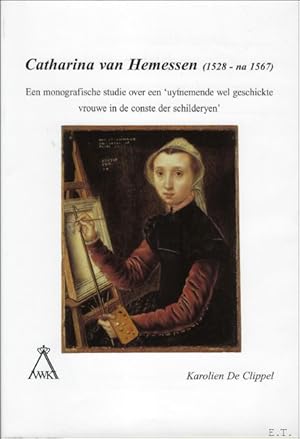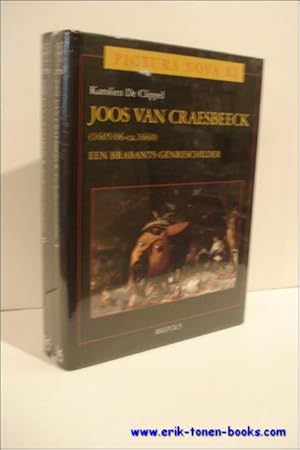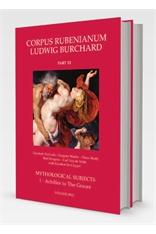K DE CLIPPEL (6 risultati)
Tipo di articolo
- Tutti gli articoli
- Libri (6)
- Riviste e Giornali
- Fumetti
- Spartiti
- Arte, Stampe e Poster
- Fotografie
- Mappe
-
Manoscritti e
Collezionismo cartaceo
Condizioni
Legatura
Ulteriori caratteristiche
- Prima edizione (1)
- Copia autografata
- Sovraccoperta (1)
- Con foto (3)
- No print on demand
Paese del venditore
Valutazione venditore
-
The Nude and the Norm in the Early Modern Low Countries (Museums at the Crossroads)
Editore: Brepols Publishers, 2011
ISBN 10: 2503535690ISBN 13: 9782503535692
Da: Revaluation Books, Exeter, Regno Unito
Libro
Paperback. Condizione: Brand New. illustrated edition. 300 pages. 11.60x8.20x0.60 inches. In Stock.
-
Catharina van Hemessen (1528 - na 1567). Een monografische studie over een uytnemende wel geschickte vrouwe in de conste der schilderyen
Editore: Brussel, Paleis der Academien, 2004., 2004
Da: BOOKSELLER - ERIK TONEN BOOKS, Antwerpen, Belgio
Membro dell'associazione: ILAB
softcover , originele geillustreerde uitgeversomslag in kleur, 26x18cm., 183pp, met 79 afb., bibliografie, index, als nieuw!!! ISBN 906569921X. Verhandelingen van de Koninklijke Academie voor Wetenschappen, Letteren en Schone Kunsten van Belgie. Nieuwe reeks, n 11. 550 g.
-
Joos Van Craesbeeck (ca. 1606 - ca. 1660). 2 VOLUMES.
Editore: Turnhout Brepols 2006, 2006
Da: BOOKSELLER - ERIK TONEN BOOKS, Antwerpen, Belgio
Membro dell'associazione: ILAB
2 volumes hardcover, dusjacket,., XVIII+608 pages., 210 b/w ill., 190 x 250 mm, Languages: Dutch ISBN 9782503515670. Joos van Craesbeeck was one of the leading genre painters in de seventeenth-century Southern Netherlands. As the only known pupil of Adriaen Brouwer, he contributed together with David II Teniers (1610-1690) and David III Ryckaert (1612-1661) to the revival of Flemish genre painting in the 1630s. His career was atypical by his combination of jobs. Originally trained as a baker, he did not start to paint until later in life, probably stimulated by the flowering of the arts in Antwerp. Initially he combined his painterly activities with the baker?s trade, but with the passing of time he devoted himself entirely to the arts. As so many painters, Joos van Craesbeeck was remarkably mobile. Coming from a prosperous and socially active family in the rather remote Hageland region, he spent his active life in the most important Brabantine cities of the era: first in Antwerp, than in Brussels. Over time, chroniclers have indulged in fantasies about Van Craesbeeck?s colourful nature to such an extent that in the nineteenth century, he and Adriaen Brouwer were presented as debauched cult heroes. Until today this romantic conceptualization determines the discourse about both painters. In the present book this image is adjusted by means of new findings about the life and work of Joos van Craesbeeck which are based on archival documents and the approximately hundred twenty paintings left behind by the artist. By situating Van Craesbeeck within the socio-economic and cultural world in which he worked, his oeuvre gains in meaning and his status as genre painter in light of reception-aesthetics is clarified. Van Craesbeeck?s works were primarily mainly intended for the free market and were bought by a cultivated and rather prosperous clientele with a sense of humour. This book is the first monograph that deals exclusively with this fascinating and non-conformist Brabantine genre painter. The catalogue raisonne forms the core of this study which -- for the first time -- assembles and describes at length Van Craesbeeck?s paintings. The preceding essay is composed of three chapters. After the chronicle of Van Craesbeeck?s fortunes focussing on the socio-economic and cultural background of the painter as well as his social status, the attention shifts from the second chapter onwards onto his work. In an attempt to reconstruct contemporary expectations, chapter 2 maps out genre-specific and decorum-related qualities of the comical paintings. Finally, a chronological outline is presented which positions Van Craesbeeck?s undated oeuvre within contemporary Netherlandish painting. Joos van Craesbeeck was n van de toonaangevende genreschilders in de zeventiende-eeuwse Zuidelijke Nederlanden. Als enige gekende leerling van Adriaen Brouwer, droeg hij samen met David II Teniers (1610-1690)en David III Ryckaert (1612-1661) bij tot de heropleving van de Vlaamse genreschilderkunst in de jaren 1630. Zijn loopbaan verliep atypisch door zijn cumul van beroepen. Oorspronkelijk was hij opgeleid als bakker. Wellicht geprikkeld door het Antwerpse artistieke elan, leerde hij nog op latere leeftijd het schildersvak aan. Terwijl hij aanvankelijk zijn schilderkunstige activiteiten met het bakkersberoep combineerde, wijdde hij zich later volledig aan het kunstenaarsschap. Zoals menig schilder in die tijd, was Joos van Craesbeeck buitengewoon mobiel. Afkomstig uit een welvarend en maatschappelijk ge ngageerd gezin in het enigszins afgelegen Hageland, bracht hij zijn actieve leven door in de belangrijkste Brabantse steden van het moment: eerst in Antwerpen, dan in Brussel. Omtrent Van Craesbeecks kleurrijke natuur werd dermate gefabuleerd dat hij tijdens de negentiende eeuw samen met Adriaen Brouwer als liederlijke cultuurheld werd opgevoerd. Deze romantische beeldvorming bepaalt nog steeds het gangbare discours over beide schilders. In dit boek wordt dit beeld bijgesteld aan de hand van nieuwe bevindingen omtrent het leven en werk van Joos van Craesbeeck op basis van archiefbescheiden en de zowat honderd twintig schilderijen die kunstenaar ons heeft nagelaten. Door Van Craesbeeck te situeren binnen de socio-economische en culturele wereld waarin hij werkzaam was, wint zijn oeuvre aan betekenis en wordt zijn statuut als genreschilder in het licht van de receptie-esthetica opgehelderd. Van Craesbeecks werken waren hoofdzakelijk bestemd voor de vrije markt en werden gekocht door een gecultiveerd, vrij welvarend en lachgraag publiek. Dit boek is de eerste monografie omtrent deze fascinerende en non-conformistische Brabantse genreschilder. 0 g.
-
The Nude and the Norm in the Early Modern Low Countries
Editore: Brepols, Turnhout, 2011
ISBN 10: 2503535690ISBN 13: 9782503535692
Da: Luigi De Bei, PREGANZIOL, TV, Italia
Libro Prima edizione
Couverture souple. Condizione: As New. Condizione sovraccoperta: As New. Edition originale. Description: Turnhout: Brepols, 2011. 30cm., pbk., 220pp. illus. Contents: Katlijne Van der Stighelen, Introduction - Eric Jan Sluijter, The Nude, the Artist and the Model: The Case of Rembrandt - Erna Kok, The Female Nude from Life: On Studio Practice and Beholder Fantasy - Victoria Sancho Lobis, Printed Drawing Books and the Dissemination of Ideal Male Anatomy in Northern Europe - Paul Taylor, Colouring Nakedness in Netherlandish Art and Theory - Hubert Meeus, Two Founts of Ivory: Nudity on Stage in the Seventeenth Century Low Countries- Johan Verberckmoes, Is that Flesh for Sale? Seventeenth-Century Jests on Nudity in the Spanish Netherlands - Ralph Dekoninck, Art Stripped Bare by the Theologians, Even: Image of Nudity / Nudity of Image in the Post-Tridentine Religious Literature - Veerle De Laet, Een Naeckt Kindt, een Naeckt Vrauwken ende Andere Figueren: An Analysis of Nude Representations in the Brussels Domestic Setting. Museums at the Crossroads (MAC) The Nude and the Norm in the Early Modern Low Countries K. Van der Stighelen (ed.) 220 p., 132 b/w ill., 210 x 297 mm, 2011 ISBN: 978-2-503-53569-2 Languages: English Paperback The publication is available. Reta - il price: EURO 85,00 Table of Contents Table of Contents : Katlijne Van der Stighelen, Introduction - Eric Jan Sluijter, The Nude, the Artist and the Model: The Case of Rembrandt - Erna Kok, The Female Nude from Life: On Studio Practice and Beholder Fantasy - Victoria Sancho Lobis, Printed Drawing Books and the Dissemination of Ideal Male Anatomy in Northern Europe - Paul Taylor, Colouring Nakedness in Netherlandish Art and Theory - Hubert Meeus, Two Founts of Ivory: Nudity on Stage in the Seventeenth Century Low Countries- Johan Verberckmoes, Is that Flesh for Sale? Seventeenth-Century Jests on Nudity in the Spanish Netherlands - Ralph Dekoninck, Art Stripped Bare by the Theologians, Even: Image of Nudity / Nudity of Image in the Post-Tridentine Religious Literature - Veerle De Laet, Een Naeckt Kindt, een Naeckt Vrauwken ende Andere Figueren: An Analysis of Nude Representations in the Brussels Domestic Setting language : english text Size: 210 X297 Mm.
-
Corpus Rubenianum Ludwig Burchard. Part. XI vol. One/Two. Mithological Subjects 1 Achilles to the Graces.
Editore: Harvey Miller Londra 2016, 2016
Da: EDITORIALE UMBRA SAS, Foligno, PG, Italia
Condizione: Nuovo. 2 voll.ril. in tela con sovr., cm 27x18, pp 469+470. Vol. One : 21 ill. in b/n. Vol. Two: 410 tavv. e ill. a col. e b/n. - ISBN: 9781909400474/7.
-
Mythological Subjects Achilles to the Graces / Rubens Corpus Rubenianum Ludwig Burchard XI
Editore: Brepols 2016, 2016
Da: BOOKSELLER - ERIK TONEN BOOKS, Antwerpen, Belgio
Membro dell'associazione: ILAB
Hardcover with dusjacket, 2 volumes., 944 pages., 362 b/w ill. + 104 colour ill., 175 x 260 mm Languages: English. ISBN 9780905203676. Corpus Rubenianum Ludwig Burchard XI One remarkable feature of European culture as it developed in the Renaissance was the accommodation it made with ancient paganism. The classical gods and their legends were allegorised, transformed into symbolic figures or emblematic scenes that might accord with Christian morality. At the same time there emerged a new, secular, genre of art devoted to the depiction of the most popular myths, above all the love stories recounted by the ancient poets. These stories were not only attractive in themselves; they offered the opportunity to depict nude figures in narrative action, which the example of antiquity held forth as the highest goal for painting. Rubens was one of the greatest creators of classical allegory; he was also a supreme interpreter of the classical stories. No painter was so at home in the literature of the Greeks and Romans. When he painted for pleasure, which, increasingly in the course of his life, he felt able to do, he used pagan myth to express and celebrate themes of love, beauty and the creative forces of nature, often in wonderfully idiosyncratic ways. Still, as a Christian committed to the ideals of the Catholic Reformation, Rubens respected the restrictions generally placed on the depiction of pagan tales. Most of his mythological paintings were made for private settings, for display within houses (including his own) or in the galleries of princes, noblemen and prelates. It is a happy accident of history that so many of these splendid paintings are now widely visible in the great museums of the world. 0 g.






